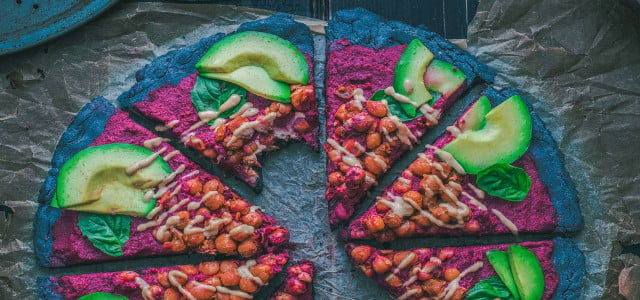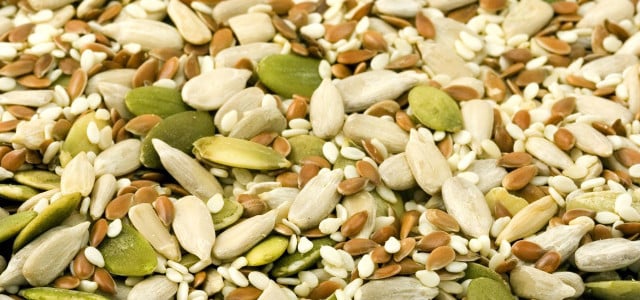The vegan food pyramid will help you eat a balanced vegan diet. You can get all the nutrients your body needs purely from plant-based foods. We’ll show you the exact structure of the vegan food pyramid right here!
What Are Food Pyramids?
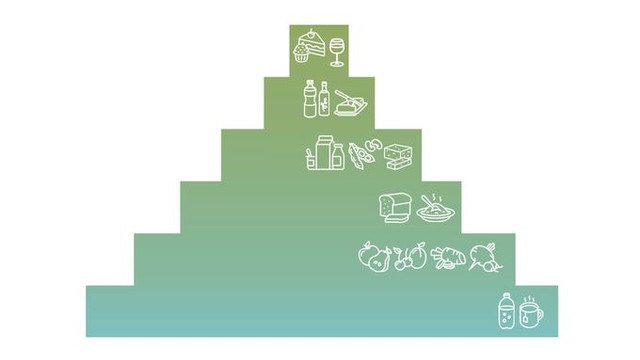
A food pyramid depicts nutritional recommendations in a pyramid form. The broad base is made up of foods that you should eat plenty of. The foods at the top, on the other hand, should only be eaten in small amounts. In this way, a food pyramid will make it easier for you to eat healthily. Our evaluation and classification of the individual food groups focus mainly on them having low energy density, but high nutrient density.
The traditional food pyramid contains meat, eggs, and dairy products. For a meat-free or strictly plant-based lifestyle, there is also a vegetarian and of course a vegan food pyramid.
What’s Special about the Vegan Food Pyramid?
The vegan food pyramid provides orientation for vegans who want to eat a balanced, healthy diet. People whose sole source of nourishment is plants must be careful to supply their bodies with all the nutrients they need. This way, we won’t feel weak, tired, or even ill as a result of malnutrition or deficiencies. PETA has a great infographic about what to look out for on a vegan diet.
The first three levels of both the vegan food pyramid and its conventional counterpart are almost identical. Changing to a vegan diet isn’t such a big leap after all!
The first three levels are:
- drinks
- fruit and vegetables
- and grains and potatoes
However, the next categories of the vegan food pyramid do not, of course, include any animal products like meat, cheese, or eggs. The three upper levels consist of:
- protein products, and nuts and seeds
- oils, fats, and salt
- sweets, snacks, and alcohol
The vegan food pyramid replaces animal sources of protein with legumes, nuts, and seeds. Fats are not found in the form of dairy products or eggs, but in the form of natural oils or vegetable spreads.
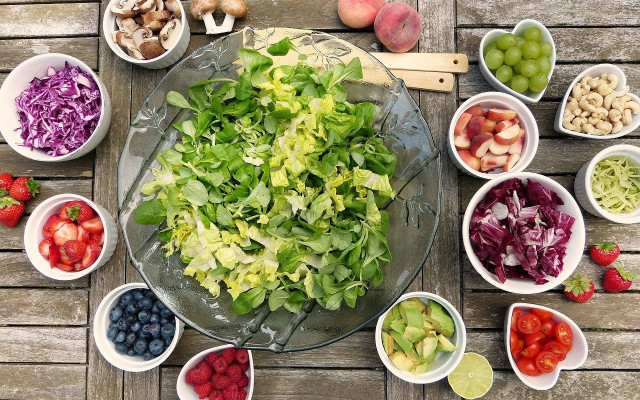


Applying the Recommendations in Real Life
In everyday life, the vegan food pyramid should serve as a practical orientation. It shows you which foods add up to a balanced vegan diet, and in which quantities. We represent the quantities in portions: one portion corresponds roughly to the amount you can hold in one hand (e.g. an apple, a slice of bread, or a glass of water). For small fruits, grains, or salad leaves, a portion is the amount that would fit in both hands cupped into a bowl.
Of course, it’s up to you to plan your meals according to the recommendations! You can choose what, when, and how you eat, according to your personal tastes, habits, and individual energy requirements.
Level 1 (Base): Drinks
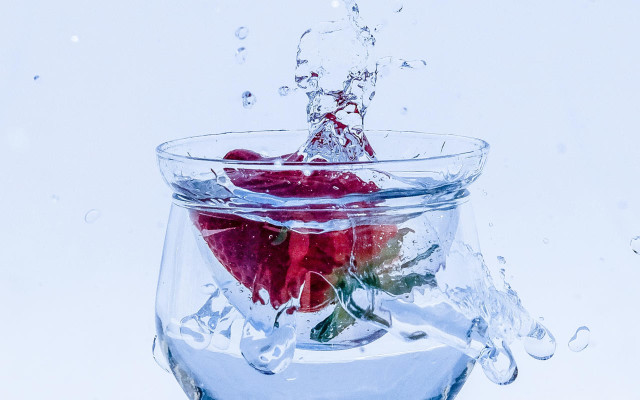


- Consuming sufficient fluids is fundamental to our nutrition, not just for a vegan diet. It’s the base of the vegan food pyramid for a good reason!
- You should be drinking one to two liters of water a day – this is about six servings. It’s fine to replace a part of this with other non-alcoholic, low-calorie drinks such as herbal teas or highly diluted fruit juices.
- You can also take on some of your liquids in the form of coffee or black tea. Don’t drink more than four small cups per day – and remember to look out for fair trade coffee!
- If you drink mineral water, we recommend calcium-rich varieties (with a calcium content of over 400 milligrams per liter). However, please note: In most western countries, tap water is of very good quality. It’s cheaper and greener to avoid bottled water wherever you can.
Level 2: Fruit and Vegetables
- You should eat three portions of vegetables (about 400 g, or 15 oz) and two portions of fruit (about 300 g, or 11 oz) a day.
- Fruit and vegetables should be the mainstay of your diet. They’re filling despite their low calorie content, and they supply the body with important vitamins, minerals, fiber, and secondary plant substances.
- You can also add dried fruit to the menu from time to time, replacing a portion of fresh fruit. Note, however, that dried fruit contains a lot of sugar – don’t eat too much of it.
- Fruit and vegetables should be bought seasonally, organically, and regionally. This way they are always fresh, have not been treated with synthetic chemical pesticides, and do not have to travel long distances – thus reducing emissions that harm the environment.
Level 3: Grains and Potatoes
- Cereals, rice, potatoes, and pseudo-cereals like quinoa or buckwheat are a really important part of the vegan food pyramid and should be part of two to three meals a day. This corresponds to about four portions.
- Wholegrain produce is particularly recommended because it contains many minerals and vitamins, as well as complex carbohydrates and fiber. This is why they keep you feeling full for a longer!
- Grains are also an important source of protein for vegans.
- Breakfast cereals, granola mixes, and granola bars don’t belong in this category. They are often very sugary and contain a lot of fat. Although they are made from cereals, you should treat them more like sweets or candy.
- You should also avoid eating potato-based products with a high fat content such as french fries every day, and if you do eat them, then not in excessive amounts.
Level 4: Protein Products, Seeds, and Nuts
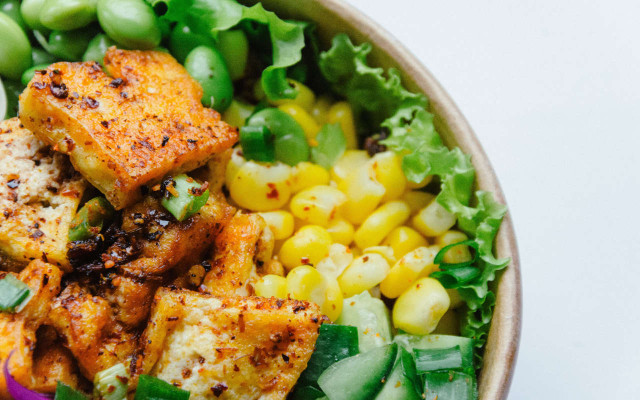


- Many people are worried about whether plant-based foods can provide them with sufficient protein. However, if you follow the guidelines of our vegan food pyramid, this won’t be a problem!
- We recommend that you put pulses on your plate several times a week – or even every day – because they are great sources of protein. You can eat three portions of unprocessed pulses (beans, peas, lentils) or lightly processed soy products (unprocessed tofu, tempeh, soy milk, vegan yogurt) a day.
- More heavily processed meat alternatives made from seitan, lupine protein, or tofu should be on the menu once or twice a week at most.
- Nuts and seeds (and spread and butter made from them) are valuable sources of protein too, and also provide vitamins, minerals, and essential fatty acids. However, they also have a high calorie content, so don’t eat more than 30 to 60 g (1 to 2 oz) of them a day.
Level 5: Oils, Fats, and Salt
- Level 5 comprises foodstuffs that you should only eat small amounts of every day.
- You can consume about two to four tablespoons of fats (e.g. vegan spreads), oils, and things like vegan cream substitute per day. Prioritize natural oils that are rich in omega-3 fatty acids (e.g. linseed, rapeseed, and walnut oil – check out this great Californian brand of walnut oil on Amazon**).
- Avoid eating too much salt. However, iodized table salt is a good source of iodine.
Level 6: Sweets, Snacks, and Alcohol
- Chips, candy, chocolate, and wine, for example, belong in this category. You should enjoy these foods as rarely as possible, in small quantities, and responsibly. They often have a high salt, sugar, and fat content.
- Eat no more than one portion of them per day.
What’s Missing from the Vegan Food Pyramid?
Some vitamins and trace elements are simply difficult to obtain from plant-based foods. Of course, there’s nothing wrong with supplementing your diet if necessary. These substances include:
- Vitamin D
- Iron
- Iodine
- Vitamin B12
Vitamin B12 is only found in animal products. So if you’re following the vegan food pyramid strictly, you’ll need to supplement your diet with B12 from another source.
What the vegan food pyramid doesn’t include are dietary supplements. If you follow our nutritional recommendations, you should be able to avoid any deficiencies. However, there are plenty of supplements that can make a vegan diet easier, as well as healthier! Check out our review of these vegan protein powders, which often contain trace elements which can be hard to include in a vegan diet.
This article was translated from German by Will Tayler. You can read the original here: Vegane Ernährungspyramide: So gelingt die gesunde Ernährung
Important Information regarding Health-related Topics.
** Links to retailers marked with ** or underlined orange are partially partner links: If you buy here, you actively support Utopia.org, because we will receive a small part of the sales proceeds. More info.Do you like this post?






